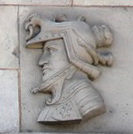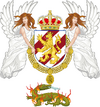| Eric VIII/IX | |
|---|---|

| |
| Eric VIII/IX | |
| King of Denmark | |
| Reign | 4th October, 1426 - 9th September, 1478 |
| Predecessor | Eric VII |
| Successor | Christopher I |
| King of Svealand and Viken | |
| Reign | 16th November, 1443 - 9th September, 1478 |
| Predecessor | Elizabeth of Viken |
| Successor | Christopher I |
| Born | 26th March, 1426 Copenhagen, Denmark |
| Died | 9th September, 1478 Nyköping, Svealand |
| Spouse | Joanna of Oldenburg Matilda of Hesse |
| Issue | Christopher I Anna |
| House | Estridsson |
| Father | Eric VII |
| Mother | Elizabeth of Viken |
Eric VIII is usually judged the first king of Denmark's 'Imperial' phase. He personally ruled over Denmark, Lade and Estonia which he inherited from his father , and would inherit Viken, Svealand and Finland from his mother.
Born in 1426, only a few months before his father's untimely death, Eric would quickly be accepted by the Danish nobility as the kingdom's rightful heir and ruler. Denmark's southern borders, and especially its recently conquered Pomeranian land, were potentially under threat from German princes and the Danish lords reckoned a united front behind a king, even if that king was a mere baby, was better than a disputed crown and division. Due to his age a council of regency was established under his mother, Elizabeth of Viken being a competent and formidable ruler in her own right.
Elizabeth quickly set about turning the fragile peace with the German princes into something more stable. This was complimented with a period of castle building along the new frontier, cementing Danish control firmly over Pomerania. While this was popular her attempts to merge the lords' councils into a singular chamber were less so and the Danish lords were much aggrieved by the influx of Vikene and Svealandic advisors.
This period of Elizabeth ruling the territories as a single entity largely ended in the summer of 1431 when she and the great lords of her and Eric's realms met in Kalmar, Gothenland. Here Eric VIII was re-acclaimed as king, and sole heir, whilst Elizabeth swore to uphold and maintain the laws of her territories. Both Hordaland and Gothenlandic diplomats signed the agreement too, binding the four entities together in a defensive alliance. More pressingly it pushed Elizabeth to the side in the Danish lands, allowed local lords more leeway in the regency and quietly shelving plans to integrate the laws and government of the lands further.
Elizabeth would die in November 1443 whereupon Eric would tour his inheritance, reconfirming laws and rights, and the lands of the nobility. On his return to Denmark at midsummer 1444 he would be handed full reign of the kingdom and the council of regency was dissolved. Eric did not deviate much from the template he had been given and mostly his reign was simply business as usual.
In 1460 Eric committed the Danish army to support William I in the War of the Lions, an Anglian civil war which had spiralled out into a general war with Wessex and Scotland. It comprised the first real test for the Kalmar Union, a test which it passed with considerable ease. Hordaland eagerly joined the fight, and many suggest King Eric VI was partly responsible for the union's involvement in the first place as he looked to make good on his claims on Man. Gothenland meanwhile did not fight or provide assistance as it was engaged with Prussia, but, to show willing, Karl VI set aside stores of food to supply to the Danish navy if it needed it. Eric landed the Danish army in Flanders which was then under duress from Wessexian forces from Normandy and, at the head of the army, scored minor victories at Dinant and Aat. He would spend another year pursuing sieges of the formidable Norman castles on the borders before returning to Denmark. This allowed William I to concentrate on Anglia successfully defending his throne from his enemies.
Toward the end of his reign he travelled to Rome, gaining permission for the papacy to establish a university in Copenhagen. Dying in 1478 he was succeeded in turn by his eldest son Christopher and then by his second son Eric.
Family[]
Eric married Joanna of Oldenburg in 1442. They had five children:
- Christopher I (1443-1485)
- Anna (1445-1511)
- Catherine (1448-1500)
- Isabella (1450-1451) (Supposedly Eric IX's elder twin)
- Eric IX (1450-1509)
Following Joanna's death in 1458 Eric married Matilda of Hesse in 1461. They had two children:
- Christian (1465-1498)
- Olaf (1468-1530)
Ancestry[]
| Ancestors of Eric VIII of Denmark (The Kalmar Union) | ||||||||||||||||||||||||||||||||||||||||||||||||||||||||||||||||||||||||||||||||||||||||||||||||||||||||||||||||||||||||||||||||||||||||||||||||||||||||||||||||||||||||||||||||||||||||||||||||||||||||||||||||||||||||||||||||||||||||||||||||||||||||||||||||||||||||||||||||||||||||||||||||||||||||||||||||||||||||||||||||||||||||||||||||||||||||||||||||||||||||||||||||||||||||||||||||||||||||||||||||||||||||||||||||||||||||||||||||||||||||||||||||||||||||||||||||||||||||||||||||||||||||||||||||||||||||||||||||||
|---|---|---|---|---|---|---|---|---|---|---|---|---|---|---|---|---|---|---|---|---|---|---|---|---|---|---|---|---|---|---|---|---|---|---|---|---|---|---|---|---|---|---|---|---|---|---|---|---|---|---|---|---|---|---|---|---|---|---|---|---|---|---|---|---|---|---|---|---|---|---|---|---|---|---|---|---|---|---|---|---|---|---|---|---|---|---|---|---|---|---|---|---|---|---|---|---|---|---|---|---|---|---|---|---|---|---|---|---|---|---|---|---|---|---|---|---|---|---|---|---|---|---|---|---|---|---|---|---|---|---|---|---|---|---|---|---|---|---|---|---|---|---|---|---|---|---|---|---|---|---|---|---|---|---|---|---|---|---|---|---|---|---|---|---|---|---|---|---|---|---|---|---|---|---|---|---|---|---|---|---|---|---|---|---|---|---|---|---|---|---|---|---|---|---|---|---|---|---|---|---|---|---|---|---|---|---|---|---|---|---|---|---|---|---|---|---|---|---|---|---|---|---|---|---|---|---|---|---|---|---|---|---|---|---|---|---|---|---|---|---|---|---|---|---|---|---|---|---|---|---|---|---|---|---|---|---|---|---|---|---|---|---|---|---|---|---|---|---|---|---|---|---|---|---|---|---|---|---|---|---|---|---|---|---|---|---|---|---|---|---|---|---|---|---|---|---|---|---|---|---|---|---|---|---|---|---|---|---|---|---|---|---|---|---|---|---|---|---|---|---|---|---|---|---|---|---|---|---|---|---|---|---|---|---|---|---|---|---|---|---|---|---|---|---|---|---|---|---|---|---|---|---|---|---|---|---|---|---|---|---|---|---|---|---|---|---|---|---|---|---|---|---|---|---|---|---|---|---|---|---|---|---|---|---|---|---|---|---|---|---|---|---|---|---|---|---|---|---|---|---|---|---|---|---|---|---|---|---|---|---|---|---|---|---|---|---|---|---|---|---|---|---|---|---|---|---|---|---|---|---|---|---|---|---|---|---|---|---|---|---|---|---|---|---|---|---|---|---|---|---|---|---|---|---|---|---|---|---|---|---|---|---|---|---|---|---|---|---|---|---|---|---|---|---|---|---|---|---|---|---|---|---|---|---|---|---|---|---|---|---|---|---|---|---|---|---|---|---|---|---|---|---|---|---|---|---|---|---|---|---|---|---|---|---|
| ||||||||||||||||||||||||||||||||||||||||||||||||||||||||||||||||||||||||||||||||||||||||||||||||||||||||||||||||||||||||||||||||||||||||||||||||||||||||||||||||||||||||||||||||||||||||||||||||||||||||||||||||||||||||||||||||||||||||||||||||||||||||||||||||||||||||||||||||||||||||||||||||||||||||||||||||||||||||||||||||||||||||||||||||||||||||||||||||||||||||||||||||||||||||||||||||||||||||||||||||||||||||||||||||||||||||||||||||||||||||||||||||||||||||||||||||||||||||||||||||||||||||||||||||||||||||||||||||||
| |||||||||||||||||||||||||||||||||||||||||
| |||||||||||||||||||||||||||||||||||||
| ||||||||||||||||||||



